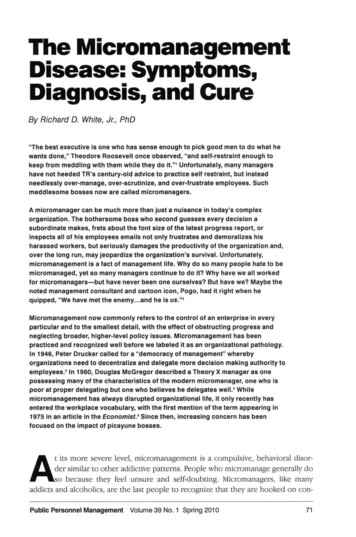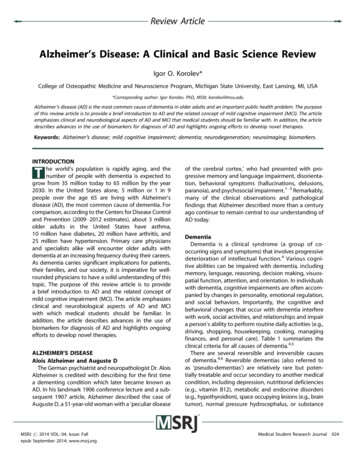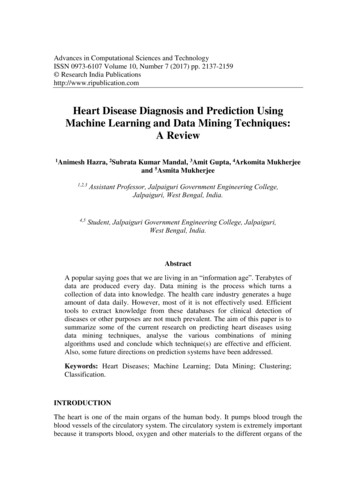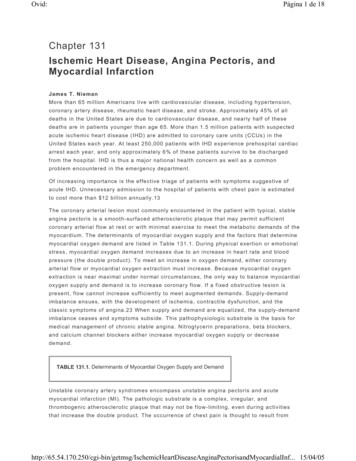
Transcription
The MicromanagementDisease: Symptoms,Diagnosis, and CureBy Richard D. White, Jr., PhD"The best executive is one who has sense enough to pick good men to do what hewants done," Theodore Roosevelt once observed, "and self-restraint enough tokeep from meddling with them while they do it." Unfortunately, many managershave not heeded TR's century-old advice to practice self restraint, but insteadneedlessly over-manage, over-scrutinize, and over-frustrate employees. Suchmeddlesome bosses now are called micromanagers.1A micromanager can be much more than just a nuisance in today's complexorganization. The bothersome boss who second guesses every decision asubordinate makes, frets about the font size of the latest progress report, orinspects all of his employees emails not only frustrates and demoralizes hisharassed workers, but seriously damages the productivity of the organization and,over the long run, may jeopardize the organization's survival. Unfortunately,micromanagement is a fact of management life. Why do so many people hate to bemicromanaged, yet so many managers continue to do it? Why have we all workedfor micromanagers—but have never been one ourselves? But have we? Maybe thenoted management consultant and cartoon icon, Pogo, had it right when hequipped, "We have met the enemy.and he is us."2Micromanagement now commonly refers to the control of an enterprise in everyparticular and to the smallest detail, with the effect of obstructing progress andneglecting broader, higher-level policy issues. Micromanagement has beenpracticed and recognized well before we labeled it as an organizational pathology.In 1946, Peter Drucker called for a "democracy of management" wherebyorganizations need to decentralize and delegate more decision making authority toemployees. In 1960, Douglas McGregor described a Theory X manager as onepossessing many of the characteristics of the modern micromanager, one who ispoor at proper delegating but one who believes he delegates well. Whilemicromanagement has always disrupted organizational life, it only recently hasentered the workplace vocabulary, with the first mention of the term appearing in1975 in an article in the Economist. Since then, increasing concern has beenfocused on the impact of picayune bosses.345At its more severe level, micromanagement is a compulsive, behavioral disor der similar to other addictive patterns. People w h o micromanage generally doso because they feel unsure and self-doubting. Micromanagers, like manyaddicts and alcoholics, are the last people to recognize that they are h o o k e d o n conPublic Personnel ManagementVolume 39 No. 1 Spring 201071
trolling others. Extreme micromanagers behave pathologically, refusing to accept per sonal responsibility or accountability and create scapegoats to blame for their o w nmistakes. They seldom develop people but instead exploit them, preferring to con trol results rather than inspiring creativity. Fearing competition, they rarely hire peo ple with the talent, experience, and know-how to challenge them. Micromanagerstend to dumb down their organizations. As they hire drones, they must work evenharder because drones take more work to manage than do thinking, industrious work ers. It becomes a vicious cycle. G o o d workers leave, more drones are hired, and theorganization begins a downward spiral in skill, morale, and productivity. N o organiza tion can be truly efficient when it is constantly re-hiring and training new workers.A g o o d manager w h o is concerned with details is not necessarily a micromanag er. Details matter, and good leaders use micro-indicators to signal bigger problems orimpending disasters. There is nothing w r o n g with being detailed oriented, especiallywhen analyzing critical reports, reviewing accidents, and compiling a budget. There isa big difference between micromanagement and monitoring, and every important taskshould have a monitoring plan to insure performance. Some areas are just too impor 6tant and cannot be over managed, such as the recruitment of the best personnel orinsuring overall customer satisfaction. But way too often the detailed-oriented bossloses the forest in the trees, becomes overly concerned with nitpicking details, andsoon begins to micromanage subordinates.In some cases, micromanagement may increase productivity over the short term,but long-term problems will eventually defeat any short-term gains. Studies haveshown that putting fear into people at work does have an impact, it does increase pro ductivity, but only temporarily. Workers become so afraid of constant criticism frommicromanaging bosses that they no longer take risks, creativity dries up, and customerservice goes down the drain w h e n frustrated employees take it out o n customers.7Symptoms of the MicromanagerSo, at what point does good detail management end and the loathsome microman agement begin? The following are some of the more likely symptoms: Micromanagers overseetheir workers too closely and spend anexcessiveamount of time supervising a particular project and telling people exactly whatto do and h o w to do it. They compulsively monitor g o o d employees as well asthose w h o are not performing well. Micromanagers are control freaks. Type A personalities are the most likely cul prits, as they are fundamentally insecure and afraid to trust the performance ofthose below t h e m .8 Micromanager typically go alone to the bosses office, as they do not wish subor dinates to gain credit. They become irritated when others make decisions with out consulting them. They explode w h e n their bosses by-pass them and godirectly to one of their subordinates.72Public Personnel Management Volume 39 No. 1 Spring 2010
Micromanagers are obsessed with meaningless details. They love numbers, lotsof them. They confuse accuracy with precision. They keep track of the numberof copies made o n the Xerox machine, count paperclips, or scrutinize the num ber of long-distance phone calls. Micromanagers come i n earlier than their employees and stay later. Employeesat first feel guilty, but no matter h o w late they stay, the micro-boss stays later.Soon they give up and stop trying. Micromanagers frequently call the office whileon vacation. Micromanagers dictate time, often creating deadlines for deadlines sake. Theydemand overly frequent and unnecessary written status reports. They are so9busy that delays happen frequently, while people wait for their input or signoff.Their inbox is always full. Micromanagers stretch themselves too thin and take o n too many projects. Theymove from one to another without completing any of the jobs. They are too busyto meet with subordinates and not available to provide guidance. Micromanagershave no idea why they are a bottleneck because they are too busy trying to doall of the jobs of the organization. Micromanagers abhor mistakes. Seldom praising, they consider their employeesincompetent and soon lose the respect of coworkers and employees. Whilequick to blame, they seldom admit their o w n mistakes and shortcomings.Micromanagement and LMX TheoryWhile anecdotal concern over micromanagement has been growing, empirical inves tigation of its occurrence and consequence remains sparse. A modest amount ofresearch does attempt to explain why some managers delegate to their subordinatesand why others do not. Because managers w h o cannot or will not delegate oftenresort to micromanagement, Leader-Member Exchange Theory, also called L M X orVertical Dyad Linkage Theory may help to explain why some managers fall into themicromanagement t r a p .10L M X researchers conclude that managers w h o are reluctant to delegate, andbecome possible micromanagers, are those that show a lack of confidence i n subor dinates' capabilities, see tasks as being too important to be left to subordinates, orview the tasks as too complex or technically difficult. Other studies report that lead 11ers w h o delegate are those willing to undertake risk, those whose workloads aregreater, and those with more job experience as supervisors. Delegation is more like 12ly w h e n subordinates have access to organizationally relevant i n f o r m a t i o n . A more13recent study concludes that more delegation is more likely w h e n a subordinate iscompetent, shares the leader's task objectives, has w o r k e d longer for the manager, isa supervisor also, and has a favorable exchange relationship with the manager.Public Personnel ManagementVolume 39 No. 1 Spring 20101473
Micromanagement and StructureThe manner in which an organization is structured can contribute to micromanage ment. Bad structure, especially in an organization that is too top heavy, can ruin g o o dpeople. Too many levels in the hierarchy give managers too few decisions to make.Supervisors with not enough to do—especially the energetic Type A's—will fill theirspare time by micromanaging employees. A good manager w h o is micromanagedfrom above may feel forced to micromanage his o w n employees, thus creating adestructive ripple effect down through the organization as supervisors and employ ees fight to make the few decisions available. Similar to micromanagement, a bloatedhierarchy also sacrifices productivity and quality, damages job satisfaction and morale,and drives away the most talented and competent people.Prescriptions for MicromanagementH o w can micromanagement be avoided? First, it must be recognized. Micromanage ment can be revealed by examining the decision flow in the organization. Are deci sions made at the proper (and lowest) level where the decision maker has theauthority, skill, and necessary information to make the decision effectively? Have tal ented employees been empowered, allowed to make decisions, and held accountablefor performance? If there is no empowerment of employees to make decisions, thenthe g o o d ones will leave. Is turnover a problem? Are there bottlenecks where man agers are taking o n too m u c h work and trying to make too many decisions?Once discovered, how can micromanagement be avoided? First, promote carefully.Just because an employee was a ball of fire and top producer does not necessarilymean that he should be promoted to a supervisory position. Because it is often moredifficult to manage a job than to do it yourself, many people cannot make the transi tion from worker to supervisor, and if incapable of doing their new job, they micromanagethose doing their o l d job. Unfortunately, some people are just b o r nmicromanagers. They cannot be trained to delegate properly, leaving no choice butto transfer, reassign or replace them.Insure that all personnel have a clear understanding of what they are expectedto do. Often micromanagement is created w h e n managers are unclear about theirduties. With no guidance from above, they never know w h e n they have done enoughand have no idea h o w their performance is being j u d g e d .15Encourage managers to delegate. To some, handing over control is horrifying,but they must soon learn that delegation is one of the most important productivityskills a manager can master. W h e n properly exercised, delegation establishes respon sibility and accountability, and builds mutual trust and reciprocity between superiorsand subordinates. Delegation produces more satisfied managers w h o are able to takeon larger jobs at higher salaries and it produces more satisfied employees w h o areable to develop a broader range of skills and thus prepared for p r o m o t i o n .7416Public Personnel Management Volume 39 No. 1 Spring 2010
Allow mistakes. Create an organizational environment that is o p e n to innovationand new ideas. W h e n mistakes happen then you k n o w employees have been empow ered with decision making authority and are taking risks.Flatten the organization by abolishing unnecessary hierarchy. Moving decisionmaking to lower levels can reduce a manager's w o r k l o a d while developing employ ees' skills, knowledge, job satisfaction, and organizational commitment.Substitute micromanagement with leadership. Be resolute with strategy but flex ible with tactics. Create an atmosphereof o p e n communications by encouragingemployees to speak up and insuring that they are heard. Value their opinions andjudgment even if you don't agree. A trusting environment starts at the top. Mistrustis contagious and tumbles quickly d o w n through the hierarchy. L M X theory suggeststhat managersmust give subordinatesenough authority to completeimportantassignments, prepare them for difficult assignments, and provide the special informa tion necessary for their task a c c o m p l i s h m e n t .17A n d finally, we need to find out if Pogo was indeed correct. We need to ask our selves if we have met the enemy [the evil micromanager], and if so, is he us.Notes1Roosevelt quote from Tuia, S. "Executive Coaching and the American President." Morgan ArticleArchive (2005).2Kelly, W. Pogo: We Have Met the Enemy and He Is Us. (New York: Simon & Schuster, 1987)3Drucker, P.F. Concept of the Corporation. (New York: John Day Company, 1946).4McGregor, D . The Human Side of Enterprise. (New York: McGRaw Hill, 1960).5Oxford English Dictionary. (New York: Oxford University Press, 1989), citation from Economist.102 (November 15, 1975), 2.Heimer, C.H.R. "How Can I Get My Boss to D o Her Job, Not Mine." Executive Female. 17(March-April 1994), 67.67Dew, J.R. Empowerment and Democracy in the Workplace: Applying Adult Education Theoryand Practice for Cultivating Environment. (New York: Westport, CT: Quorum Books, 1997), 14.8Heimer, p. 67.9Ibid. (Heimer)1 01112Dansereau, F. Jr, Graen, G . and Haga, W.J. (1975) "A vertical linkage approach to leadershipwithin formal organizations: A longitudinal investigation of the role making process,"Organizational Behavior and Human Performance, 13: 46-78; Graen, G . , and Cashman, J.F.(1975). "A role making model of leadership in formal organizations: A developmentalapproach." In J.G. Hunt and L.L. Larson (eds), Leadership frontiers, Kent, O H : Kent StateUniversity Press.Leana, C.R. (1987) "Power relinquishment versus power sharing: Theoretical clarification andempirical comparison of delegation and participation, "Journal of Applied Psychology, 72: 228233; Hollingsworth, A.T. & Al-Jafary, A.R.A. (1983) "Why supervisors don't delegate andemployees won't accept responsibility," Supervisory Management, 28, 4, 12-17.Matthews, S. (1980). "The gentle art of delegation," Accountancy, 91: 104-106; Leana, C.R.(1986) "Predictors and consequences of delegation," Academy of Management Journal, 29:754-774; Seversky, P.M. (1982) "Trust, need to control, and the tendency to delegate: A study ofthe delegation behavior of superintendents," Dissertation Abstracts International, 43, 9A: 2851-Public Personnel ManagementVolume 39 No. 1 Spring 201075
131415Bass, B . M . & Valenzi, E. (1974) "Contingent aspects of effective management styles," in J.G.Hunt and L.L. Larson, (eds.), Contemporary Approaches to Leadership. Carbondale: SouthernIllinois University Press, 130-152; Shapira, Z. (1976) "A facet analysis of leadership styles,"Journal of Applied Psychology, 61: 136-139.Yukl, G . and Ping Ping Fu (1999) "Determinants of delegation and consultation of managers,"Journal of Organizational Behavior, 20, 2, 219-232.Hymowitz, C. "The Confident Boss Doesn't Micromanage or Delegate Too M u c h . " Wall StreetJournal. 241. (March 11, 2003), B1.16Dew, p. 111.1 7Graen, G.B. (1989) Unwritten Rules for Your Career. New York: Wiley, 58-63.AuthorRichard D. White, Jr., PhDMarjory B. Ourso Excellence in Teaching ProfessorPublic Administration InstituteRoom 3200 CEBA BuildingLouisiana State UniversityBaton Rouge, LA 70803(225) 578-6738Rdw121@aol.comDr. Richard D. White is the Marjory B. Ourso Excellence in Teaching Professor atLouisiana State University and teaches in LSU's Public Administration Institute. Whitereceived his PhD from Pennsylvania State University. He is the author of Roosevelt theReformer: Theodore Roosevelt as Civil Service Commissioner, 1889-1895 (University ofAlabama Press: 2003) and Kingfish: The Reign of Huey P. Long (Random House: 2006)and has published in numerous scholarly journals, including PublicReview, Policy Studies Review, Journal of Public AdministrationPublic Integrity, fournalAdministrationResearch and Theory,of Management History, International Journal oftion Theory and Behavior, Commonwealth:Organiza-A Journal of Political Science, andTheChristian Science Monitor. From 1991-1992, White was a National Security Research Fel low at Harvard University where he studied leadership and ethics and taught a publicpolicy seminar within Harvard's Institute of Politics.76Public Personnel Management Volume 39 No. 1 Spring 2010
COPYRIGHT INFORMATIONAuthor: White, Richard D.Title: The Micromanagement Disease: Symptoms, Diagnosis, and CureSource: Public Pers Manage 39 no1 Spr 2010 p. 71-6ISSN: 0091-0260Publisher: International Personnel Management Association1617 Duke St., Alexandria, VA 22314The magazine publisher is the copyright holder of this article and it is reproducedwith permission. Further reproduction of this article in violation of the copyright isprohibited. To contact the publisher: http://www.ipma-hr.orgThis article may be used for research, teaching and private study purposes. Any substantial or systematic reproduction, re-distribution, re-selling, loan or sublicensing, systematic supply or distribution in any form to anyone is expressly forbidden. The publisher does not give any warranty express or implied or makeany representation that the contents will be complete or accurate or up to date. The accuracy of any instructions, formulae and drug doses should be independentlyverified with primary sources. The publisher shall not be liable for any loss, actions, claims, proceedings, demand or costs or damages whatsoever or howsoevercaused arising directly or indirectly in connection with or arising out of the use of this material.
Diagnosis, and Cure By Richard D. White, Jr., PhD "The best executive is one who has sense enough to pick good men to do what he wants done," Theodore Roosevelt once observed, "an










